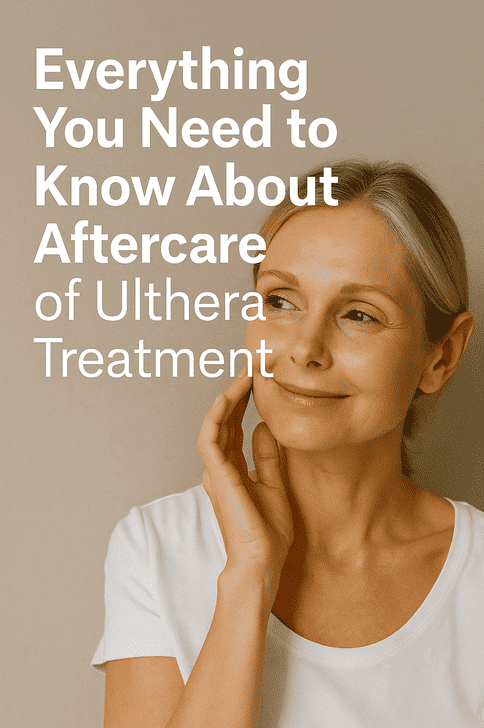Maintaining youthful, healthy skin is difficult. Age spots, wrinkles, and sun damage can make you appear older than you actually are. You don’t have to put up with aging skin, which is fantastic news. There are procedures that might make you appear more youthful and renewed. One such procedure is ulthera or also known as Ultherapy.
So, What Is Ultherapy?
The protein collagen provides the skin with its strength and structure. Wrinkles and drooping skin are caused by our body producing less and less collagen as we age. Using a medical gadget, the treatment applies concentrated ultrasonic energy to the skin’s deep layers.
The body’s natural healing reaction is triggered by this, and new collagen is produced. As new collagen is created, the outcomes will continue to get better over the next months and look more natural.
After Treatment, How Long Will the Results Last?
The skin on the face, neck, and brow will visibly tighten and lift over the course of two to three months, while the benefits are not noticeable right away. Results can last up to two years, with the majority of patients experiencing their best outcomes six months after therapy.
Since every person ages differently, some patients may receive long-lasting benefits from a single therapy session, while others may need to return once a year to sustain their gains.
It may take a few weeks for Ultherapy to begin producing benefits since it stimulates the production of new collagen. Results will take three months or longer to manifest, but most patients only require one treatment.
You can anticipate that your skin tightening results will continue for up to five years after you see them. To maintain the lifted, firm appearance of their Ultherapy results, many patients plan yearly maintenance treatments. Although this treatment can “turn back the clock” on facial and neck aging, it cannot reverse the gradual effects of gravity and collagen loss.
Basic Tips for Ultherapy Aftercare
- Give the anti-anxiety drug up to two hours to take effect. Before starting any activity, make sure you feel stable on your feet.
- After the effects of medication wear off, you can take a shower and wash your skin.
- The treatment area can be cleaned with a mild cleaner.
- Using lukewarm water, apply it to the fingertips and massage the skin in light circular motions.
- For two weeks following the surgery, avoid tanning or extended sun exposure. To prevent unintentional sun exposure, apply a broad-spectrum sunscreen to the treated region for a maximum of two weeks.
- To enable the anesthetic to be discharged from the skin, sleep for two to three nights raised up on multiple pillows.
Comfort Measures
- For mild irritation, antihistamines such as Zyrtec and Benadryl may be prescribed.
- For swelling or discomfort, ibuprofen, acetaminophen, or Aleve are suitable.
- Bruising can be treated using Arnica Gel.
- Please contact your doctor if you have severe swelling or any other unexpected symptoms.
- Ice or cool packs can minimize minor discomfort and lessen swelling and bruises for up to 48 hours after treatment. Ice for no more than 20 minutes each hour. Use hot packs after 48 hours.
Ultherapy Post-Treatment Expectations
- Ulthera treatment is an excellent noninvasive substitute for plastic surgery, which means that there is little recovery time, side effects, or downtime and it is widely regarded as safe.
- Once the effects of any anxiety medications have worn off, you can resume your regular activities.
- The majority of therapy side effects shouldn’t raise any red flags. As a natural part of the healing process, symptoms are often mild and should go away with time. They can be lessened by doing the easy steps mentioned above.
- Your skin may seem flushed right after treatment, but this normally goes away in a few hours.
- Swelling and bruising for a week or more is common.
- For as long as two or three weeks, there may be tingling, pain, numbness, and stiffness, particularly beneath the jowls.
- If a superficial transducer is utilized, there is a small chance that the operation will result in transient welts, which typically go away in a few days.
Is Ultherapy a Good Fit for Me?
Ultherapy may be a good option for you if you are a healthy adult who has mild to moderate skin laxity around your neck, jaw, and chin. Ultherapy often works best on patients 65 years of age or younger because it depends on the skin’s capacity to produce new collagen.
All skin tones and kinds can safely undergo this non-invasive procedure. Candidates should be aware that Ultherapy results differ from those of surgery and have realistic expectations.
Ulthera treatment skin tightening may not be a good option for you if you have an electrical implant, such as a pacemaker, active skin diseases in the treatment area, an infection, or a predisposition to scar unnaturally (keloid development). Before beginning therapy, your knowledgeable physician will go over your medical history.






